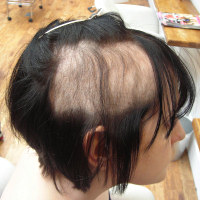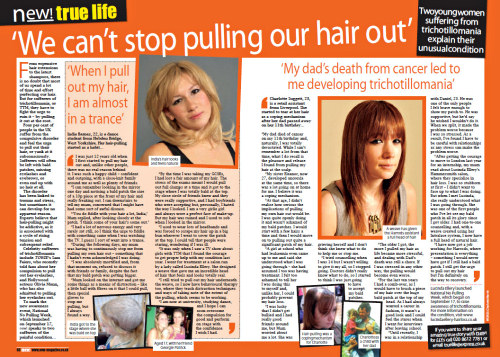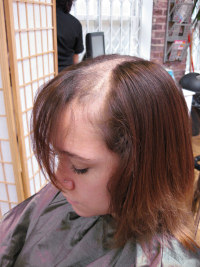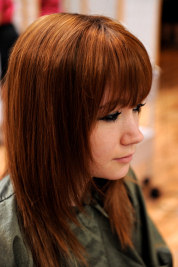Some Basic Facts
Trichotillomania is a condition where someone has the irresistible urge to pull their own hair out. It affects up to 2% of the population and is more common in females. It is also known as TTM, Trich or Tricho.
What are the signs?

Hair pulling commonly starts at the ages of 12 or 13 and can coincide with puberty. There are varying degrees of severity. The most common areas to pull from are behind the ears and the crown or top of the scalp. Some people will continuously pull from the same areas and others will move around the scalp.
Visible hair loss is inevitable from repeated pulling but people with Trich tend to become masters at disguising it by having their hair in a certain style or by using make up to cover the patches. However it’s very hard to manage the pulling without proper support, so in many cases the area of pulling can increase dramatically over a period of time.
Varying degrees of severity of TTM
Everyone is different – some pull regularly every day while others may have longer spells between pulling. Some pull from specific areas and if done frequently this can lead to a completely bare patch in one place while the rest of the head is unaffected. Some start in one place and gradually work outwards so that a larger and larger area becomes sparse, or in extreme cases, bare. The more intense the pulling the more likely that permanent damage can be done. While the scalp is the most common place, there are some who pull from their eyebrows and eyelashes – either instead of or as well as the scalp.
Awareness – public and professional
For a long time, little was known about TTM and finding out about it was difficult. Most people hadn’t heard of it, even doctors, and many sufferers thought themselves unique. Thankfully in recent years there has been much more information available and more and more people are aware of it.
It is often grouped with Obsessive Compulsive Disorders, though experts still argue about that. The medical profession in general seem to have a better awareness and understanding. There are now forums on the internet offering information and advice, and many sufferers are posting videos on sites like Youtube where they describe their condition and the ups and down of fighting it. It has been written about in various magazines and newspapers and has been featured on TV shows like This Morning and Embarrassing Illness.
However despite this increased awareness,such is the isolating effect of it that most people with Trich are really shocked to discover that they are not the only one suffering from this condition, and are often very surprised to find out that it actually has a name.
There is unfortunately a degree of secrecy with trichotillomania – people are too embarrassed to mention it to anyone else and their friends or family may just assume that they have alopecia. It’s rare for someone to openly discuss their hair pulling. We’re frequently told by new clients that we are the first people they’ve ever talked to about it, and that step alone is often a source of relief to them.

When, Where and Why?
It is usually more likely that the hair pulling happens in private – so either in the privacy of the bedroom when no one else is there or in the bathroom where the door can be locked. People with trich will often say that they find themselves in a trance-like state where they have spent possibly a number of hours pulling their hair out without even realising. Sometimes this happens when they’ve been reading or studying, and they only become aware of it when they see a clump of hair next to them.
They may say that it is comforting – there is a release of stress when the hair is pulled. Though it doesn’t necessarily happen only when you are stressed or unhappy – it can also happen when you are feeling quite relaxed – but the feelings post-pulling are always very negative. You don’t want to do it but you just can’t stop.
In some cases there is an underlying problem that triggers the first pulling event – emotional problems with family such as a death or a divorce, or problems at school or work are often mentioned – but in others there is no obvious cause. But once started the urge to pull again becomes irresistible.
Having a ongoing bad hair day
Having trich tends to really rule your day. You’ll have to spend a considerable amount of time arranging your hair to cover the hair loss, so often clients will mention that they have to get up much earlier than normal so that they have time to do the tedious task of disguising the bare patches. You will avoid many social situations – sleepovers are difficult and the prospect of that special someone touching your hair can fill you with dread. Any activity which means getting your hair wet is a big no no. A simple thing like the subject of hair in conversation can be really difficult. Some people will even adapt their sense of fashion to accommodate wearing a hat – they don’t really want to wear a baseball cap but they need it to cover the hair loss.
My child has it – What do I do?
If you suspect your child is pulling their hair out then a telling off is not appropriate. They may already want to stop but simply can’t. They need your support and help, both personally and in order to find professional advice.
Try to be aware of how long they are spending alone in their bedroom, perhaps suggest they study or watch TV in the kitchen or sitting room. You may notice that their hands are constantly in their hair so use a distraction to get their hands away from their hair.
If your child is very young and you suspect they are pulling their hair then put some Vaseline in your hands and rub it through their hair. This makes the hair slippy and very hard to grip on to.
Bear in mind that someone will trich will have mastered how to pull their hair with their nails being a certain length so for example if someone has always had short nails and they are suddenly longer they will find it very difficult to pull the hair. So if appropriate you may want to change their nails.
What can be done to help?
The first thing to realise is that while it can seem impossible to begin with it’s entirely possible for the pulling to be effectively managed and stopped with the right help.
A visit to your GP would be the first step. Hopefully your GP will be aware of the condition but if not they may take the opportunity to do some research on the subject. If they aren’t aware then ask to be referred to a specialist. Thankfully it’s very rare for a GP not to be sympathetic but if you find it’s dismissed as not being important then don’t be afraid to see another doctor.
Cognitive Behavioural Therapy is commonly reported to greatly help control urges and help with managing TTM. Your GP may refer you to one or you can find one yourself. (You may find www.babcp.com useful for this.)
You should first check that the Therapist sees clients with Trich (some do and some don’t). A number of sessions with the Therapists would normally be recommended. The success of any type of treatment will of course be governed to a degree by the attitude of the person with the problem. If they are willing to be helped then the chances are it will work but if they are not willing then it is unlikely to be successful.
Our own approach
Sufferers who come to us are given a number of techniques including relaxation and distraction, and are offered the chance to take part in a “buddy” system and social support meetings. We’ve also found that our Intralace System can be a valuable tool.
The Intralace has two ways of working for clients with TTM:
- It will disguise any areas of hair loss – helping the client to look and feel good about themselves
- It helps as a physical barrier to the pulling site – preventing the hands from reaching the hair roots and gradually breaking the habit of doing so
It is not a cure but it makes access to the areas of pulling very difficult as the scalp is covered with a mesh which in turn is covered with hair. This gives the scalp a chance to recover and for regrowth to occur if there is no permanent damage.
There is a tremendous sense of normality associated with using the system – you have a full head of hair again so it certainly reinstates some of that much-needed self esteem. And that sense of normality coupled with the physical prevention from pulling can give you the space you need to help break the cycle.


Many people with Trichotillomania will say that trying to manage their hair pulling without any support is extremely difficult, but the facts are that many do become “pull free” and move on with their lives – because they found the right help.
It’s best to take control of Trich rather than it controlling you – and asking for help is the first step.
Further information
Our main UK website has further information and videos about Trichotillomania including the Channel 4 documentary, Girls on the Pull.


